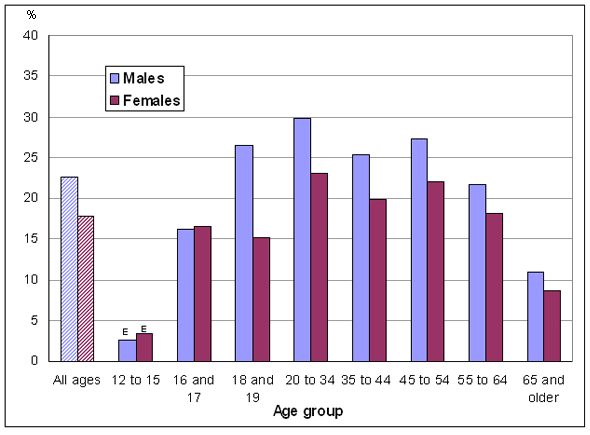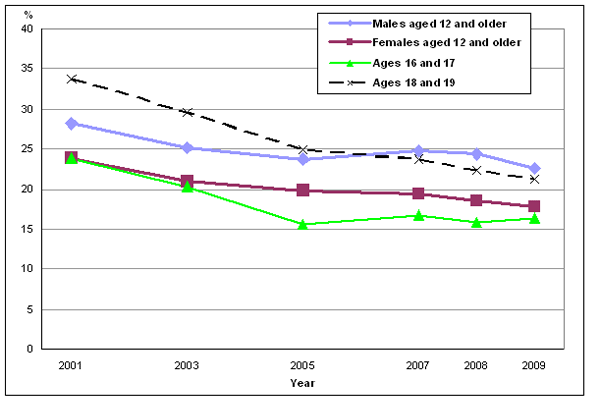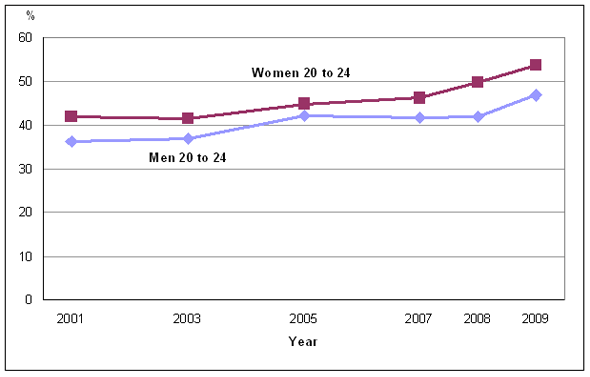Smoking, 2009
Archived Content
Information identified as archived is provided for reference, research or recordkeeping purposes. It is not subject to the Government of Canada Web Standards and has not been altered or updated since it was archived. Please "contact us" to request a format other than those available.

Smoking is a risk factor for lung cancer, heart disease, stroke, chronic respiratory disease, and other conditions.1 According to the World Health Organization, smoking is an important and preventable cause of death.2
In 2009, 5.7 million Canadians, or 20.1% of those 12 years and older smoked either daily or occasionally—22.6% of males and 17.7% of females (Chart 1). For males, this was a significant decrease from 24.4% in 2008; and for females it was a significant decrease from 19.4% in 2007.
Chart 1
Percentage who smoke daily or occasionally, by age group and sex, household population aged 12 and older, Canada, 2009

Note: E use with caution (coefficient of variation 16.6% to 33.3%)
Source: Canadian Community Health Survey, 2009.
The percentage of smokers 16 to 17 years old decreased over the six years from 20.3% in 2003 to 16.4% in 2009, though there was no significant change from 2008 to 2009. Smokers aged 18 to 19 decreased from 24.8% in 2005 to 21.2% in 2009 (Chart 2).
Chart 2
Percentage who smoke daily or occasionally, by sex and selected age groups, household population aged 12 and older, Canada, 2001 to 2009

Source: Canadian Community Health Survey, 2001, 2003, 2005, 2007, 2008 and 2009.
The lowest smoking rates were among youths aged 12 to 15 (3.0%) and seniors (9.6%). Although the lowest smoking rates were at both ends of the age spectrum, the types of smokers were different. Among seniors who were smokers, 84.0% smoked daily, while 61.4% of smokers aged 12 to 19 did so. Non–smokers in these age groups were different as well: 59.7% of senior non-smokers were actually former smokers, compared with 10.8% of non-smokers 12 to 19 years old.
People typically begin smoking during their teenage years, so the percentage of Canadians who have not started by age 20 is an indicator of future smoking rates. In 2009, 50.2% of Canadians aged 20 to 24 had never smoked, an increase over 2008 (Chart 3).
Chart 3
Percentage who never smoked, by sex, household population aged 20 to 24, Canada, 2001 to 2009

Source: Canadian Community Health Survey, 2001, 2003, 2005, 2007, 2008 and 2009.
Just under one–quarter of residents smoked in Newfoundland and Labrador, Nova Scotia, Quebec and Alberta, significantly above the national average. The rates in Ontario (18.6%) and British Columbia (16.0%) were below the national average. In the remaining provinces, the rates were not significantly different from the national figure.
Smoking rates were much higher in the territories. More than half of Nunavut residents aged 12 and older were daily or occasional smokers, as were about one-third of those in Yukon and the Northwest Territories.
End notes
1. Shields, Margot. 2005. "The journey to quitting smoking." Health Reports. Vol. 16, no. 3. May. Statistics Canada Catalogue no. 82-003. p. 19.
/studies-etudes/82-003/archive/2005/7839-eng.pdf (accessed May 11, 2010).
2. World Health Organization. 2008. WHO Report on the Global Tobacco Epidemic, 2008: The MPOWER Package. Geneva.
References
Shields, Margot. 2007. "Smoking bans: Influence on smoking prevalence." Health Reports. Vol. 18, no. 3. August. Statistics Canada Catalogue no. 82-003. p. 9–24.
/pub/82-003-x/2006008/article/smoking-tabac/10306-eng.pdf (accessed May 11, 2010).
Shields, Margot. 2005. "The journey to quitting smoking." Health Reports. Vol. 16, no. 3. May. Statistics Canada Catalogue no. 82-003. p.19–36.
/studies-etudes/82-003/archive/2005/7839-eng.pdf (accessed May 11, 2010).
Shields, Margot. 2005. "Youth smoking." Health Reports. Vol.16, no. 3. May. Statistics Canada Catalogue no. 82-003. p. 53–57.
/studies-etudes/82-003/archive/2005/7840-eng.pdf (accessed May 11, 2010).
World Health Organization. 2008. WHO Report on the Global Tobacco Epidemic, 2008: The MPOWER Package. Geneva.
Data
Additional data from the Canadian Community Health Survey are available from CANSIM table 105–0501.
- Date modified:
